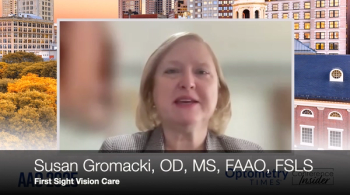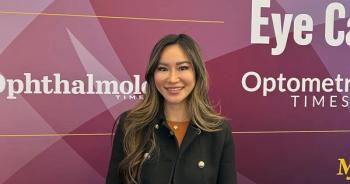
An allergist talks allergy
Andrew M. Brown, MD, is an allergist and immunologist with 47 years of experience and practices in otolaryngology, allergy, and immunology, and has been in practice in Gadsden, AL for the last 40 years. He graciously took time from his extremely busy practice, the largest allergy practice in the area, to talk with me. I started with the question: What would you like to tell an in-the-trenches optometrist about allergy?
Large papillae in SAC
Large papillae in SAC
Uniform papillary reaction in SAC
Spring is the time of year for
Articles about
Andrew M. Brown, MD, is an allergist and immunologist with 47 years of experience and practices in otolaryngology, allergy, and immunology, and has been in practice in Gadsden, AL for the last 40 years. He graciously took time from his extremely busy practice, the largest allergy practice in the area, to talk with me. I started with the question: What would you like to tell an in-the-trenches optometrist about allergy?
Allergies change
Remember that allergic disease changes. “The running joke in our profession is that allergists earn their reputation in the spring and lose it in the fall when another set of allergens erupt,” said Dr. Brown.
He advised optometrists to avoid thinking of allergy as a straightforward static condition, like a railroad track. “Think of it as a winding, curving road,” he said. “You may think you have the patient’s condition under control, then something in his environment changes.
Keeping the patient’s environment-big and small-in mind is key to discovering the offending allergen. “In our area we have a lot of lakes, so I see a lot of allergies to molds,” said Dr. Brown. “There is a lot of agriculture in our area, and I see a lot of pesticide allergies. A new cat moves next door, a new plant blooms, or something presents that the patient is sensitive to, and her symptoms return. You can also look at the prevailing weather patterns. Again, here in our area the winds blow from southwest to northeast. I’ll start seeing tree pollens from the gulf coast initially before I see allergies from the tree pollens in our region.”
He reminded us that allergy is the body’s way of building up a defense against an assault. “One great example you hear about all the time is about a patient who moves to the desert southwest,” he said. “Lo and behold, his allergies clear up. He loves it. Then the tumbleweed blooms, the patient develops a sensitivity, and his allergies return. The patient’s own natural sensitivity is the problem. An allergy is the body’s way of letting it know what’s coming.”
Allergies can sometimes come on quite quickly. Food allergies are good example. Advise patients with food allergies to carry an Epi-Pen.
Allergy testing
How does allergy testing fit into the mix? Testing is a large part of Dr. Brown’s day.
“Most MDs consider allergy a diagnosis of exclusion-they treat the symptoms but don’t look at the cause,” he said. “Asthmatic patients are a good example of this, and to be clear, I don’t treat asthmatic patients. Most asthmatic patients have allergies, but pulmonologists by and large don’t consider allergies as part of the patient’s differential diagnosis. They are missing an opportunity to discover the patient’s true problem. Yet appropriate long-term therapy requires that we flesh out the cause. This is especially important in immunotherapy. First, you have to know what you’re defending against.
In the ophthalmic arena, the conjunctival provocation test is available. This test is a human model of ocular allergy that has been used to study the ocular response to allergenic stimuli and to evaluate therapy. The conjunctival provocation test allows investigators to recruit allergic individuals who are challenged with the conjunctival administration of allergen. Observations of the eye are made before and after challenge, and cells and mediators may be sampled from the ocular surface. In addition, the effectiveness of potential therapies can be evaluated, usually by pretreating the two eyes with different forms or doses of drug. Dr. Brown considers this test to be a bit drastic.
Allergy treatments
Antihistamines are frequently a go-to treatment for allergies. I asked Dr. Brown his opinion of antihistamines. He said he has two reasons for staying away from them.
“First , they affect the outcome of allergy testing.,” he said “Second, the most effective antihistamines make the patient drowsy. Benadryl (diphenhydramine, Johnson & Johnson) is the worst. Except in cases of mild allergies, antihistamines that don’t make patients drowsy don’t work especially well.
Knowing what treatments target which allergies, and knowing how much to prescribe for each patient is important. “With any treatment, you have to find the optimal dose,” Dr. Brown said. “It may take weeks to months to find an optimal therapeutic level.”
Allergy epidemiology
Anecdotally, many practitioners think that allergy is on the rise. Numbers back that up. Older population studies estimate a prevalence of 15%–20% of allergic conjunctivitis, but more recent studies implicate rates as high as 40%.2 Dr. Brown said he’s seeing more cases than he has in the past.
“People definitely recognize allergy more that they did in the past, and now they’re seeking treatment,” he said. “Children in particular stay inside more than they did a generation ago-they aren’t exposing themselves to outdoor allergens.”
Dr. Brown believes a link exists been hygiene and allergies. The better the patient hygiene, the more the patient will suffer from allergies. The worse your patient’s hygiene, the fewer allergies he seems to have.
Final advice to ODs
Dr. Brown cautions optometrists to keep allergies in mind even during a simple refraction.
Said Dr. Brown: “Allergies will cause fluid retention in the eye and therefore change the focal point of the eye. Optometrists must recognize that the patient’s refraction will change during allergy season.”
His observation regarding refractive error and allergies has been proven. In a 2009 study,3 the spherical equivalent and spherical power were significantly lower in patients with allergic conjunctivitis than in patients without allergic conjunctivitis.
Dr. Brown makes great points about the ever-changing nature of allergy and our need to be vigilant in the care of our patients suffering from ocular allergy. Just because we may have helped the patient with one episode doesn’t mean the patient won’t return with another as the seasons change. His point about vision and refractive error in our patients with the condition should especially strike home. The patient’s transient vision changes in an episode may not be just from his watery eyes. It may represent a subtle change in their refractive correction as well.
References
1. Friedlaender MH. Conjunctival provocation testing: overview of recent clinical trials in ocular allergy. Curr Opin Allergy Clin Immunol. 2002 Oct;2(5):413-7.
2. Rosario N, Bielory L. Epidemiology of allergic conjunctivitis. Curr Opin Allergy Clin Immunol. 2011 Oct;11(5):471–6.
3. Mimura T, Mimura Y, Arimoto A, et al. Relationship between refraction and allergic conjunctivitis. Eye (Lond). 2009 Jan;23(1):63-6.
Newsletter
Want more insights like this? Subscribe to Optometry Times and get clinical pearls and practice tips delivered straight to your inbox.


















































.png)


